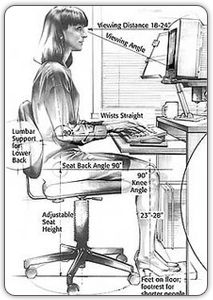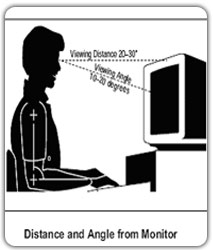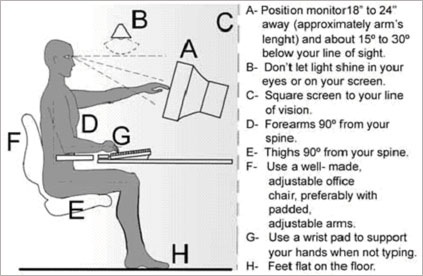Common Eye Problems
- Services
- Common Eye Problems
Common Eye Problems
The professionals spend increasing amounts of time sitting at their computer work-stations. At the same time productivity is increasing and workers are exposed to working at high speed and to tight deadlines.
The combination of fixed and constrained body postures, work overload and unsuitable workstations can lead to health problems. The most common complaints among computer users are aches and pains in the shoulder, forearm, wrist, hand, back and neck and eye strain.
RSI (Repetitive Strain Injury) is a blanket term that is used to describe many different types of work-related disorders and injuries to the upper limbs as a result of muscular overload. This overload is usually caused by repetitive movements and/or overuse of specific muscle groups (categorized as static load), especially if the joints adopt extreme positions.
This leaflet is intended to prevent health problems among computer users. Clearly a large percentage of computer workers experience eye symptoms and subsequently seek eye care. Computer vision syndrome is that set of eye care. Computer vision syndrome related to near work which are experienced during or related to computer use.
These symptoms can include:
- Head aches
- Eyestrain
- Blurred vision
- Dry or irritated eyes
- Neck aches
- Back aches
- Light Sensitivity
- Double vision
- Your workplace conditions
- Your working habits
- Tour visual condition
The computer workstation:
The chair: When you sit, the weight on your lower back is one and a half to two times bigger than when you stand.
A good chair must accommodate your body sizes and must be adjustable in the following areas:
- Height of the seat: When your feet rest comfortably on the floor, a 90 degree angle between upper and lower legs is desirable. In this position, your upper legs are virtually horizontal.
- Depth of the seat: The clearance between the front edge of the seat and the back of your knee must fit a clenched first.
- Backrest: The backrest must support the area from the upper ridge of the pelvis to the shoulder blades. The curve in the backrest must support the hollow in your lower back. An adjustable tilt is desirable.
What are the primary factors that determine discomfort for computer users?
- Nature of the task
- Length of time spend at the computer
- Reduced rate blinking
- Lack of coordination between the design of the workstation and the design of the glasses or contact lenses used for the task.
Here are some examples of situations that usually increase user discomfort especially to the eyes.
- Intense tasks such as games.
- Tasks with few breaks from the screen.
- Tasks which require constant looking from the copy to screen such as data entry.
- Detailed tasks such as desk top publishing or Computer Assisted Design (CAD).
- Eye level placement of screens causes eyes to be wide open causing faster drying.
- Eye level screens are too high for most bifocal wearers unless they have specially designed glasses for this task.
- Many glasses exacerbate the restriction of movement which is a consequence of most computer tasks causing neck, shoulder, and arm problems.
The average rate of blinking is 12 to 15 times per minute. This is frequently reduced during intensive tasks, leading to visual fatigue and dry eyes. Therefore, reading from a screen reduces blinking, which in turn, leads to discomfort.
Lighting: Good lighting design can significantly help reduce discomfort due to glare. Light leaving the fixture can be directed so that it goes straight down and not into the eyes of the room occupants. This is most commonly accomplished with the louvers in the luminaries or fixture. An even better solution is indirect lighting in which the light is bounced off the ceiling – resulting in a large low luminance source of light for the room.
- Dry Eyes
- Conjunctivitis
- TEARING
Dry eyes is a common condition that occurs when your tears can’t provide adequate lubrication for your eyes.
Signs and symptoms, which usually affect both eyes, may include:
- A stinging, burning or scratchy sensation in your eyes
- Stringy mucus in or around your eyes
- Sensitivity to light
- Eye redness
- A sensation of having something in your eyes
- Difficulty wearing contact lenses
- Difficulty with nighttime driving
- Watery eyes, which is the body's response to the irritation of dry eyes
Blurred vision or eye fatigue
Prevention
- Avoid air blowing in your eyes.
- Add moisture to the air.
- Consider wearing sunglasses or other protective eyewear
- Take eye breaks during long tasks.
- Be aware of your environment.
- Position your computer screen below eye level
- Stop smoking and avoid smoke
- Use artificial tears regularly.
Treatment
See your Doctor if you have prolonged symptoms of dry eyes. Your Doctor will determine the underlying cause and treat you accordingly.
It is an inflammation or infection of the transparent membrane (conjunctiva) that lines your eyelid and covers the white part of your eyeball.
Symptoms
The most common symptoms include:
- Redness in one or both eyes
- Itchiness in one or both eyes
- A gritty feeling in one or both eyes
- A discharge in one or both eyes that forms a crust during the night that may prevent your eye or eyes from opening in the morning
Causes
- Viruses
- Bacteria
- Allergies
- A chemical splash in the eye
- A foreign object in the eye
- In newborns, a blocked tear duct
Preventing the spread
Practice good hygiene to control the spread of pink eye. For instance:
- Don’t touch your eyes with your hands.
- Wash your hands often.
- Use a clean towel and washcloth daily.
- Don't share towels or washcloths.
- Change your pillowcases often.
- Throw away your eye cosmetics, such as mascara.
- Don't share eye cosmetics or personal eye care items.
Treatment
Do not self-medicate yourself. Consult your Doctor who will treat you according to the type of conjunctivitis
Make Appointment
- 10.00 AM - 08:00 PM , Monday - Friday
- 9.30 AM - 05:00 PM , Saturday
- Holiday , Sunday
- https://bit.ly/3rkHIwO




